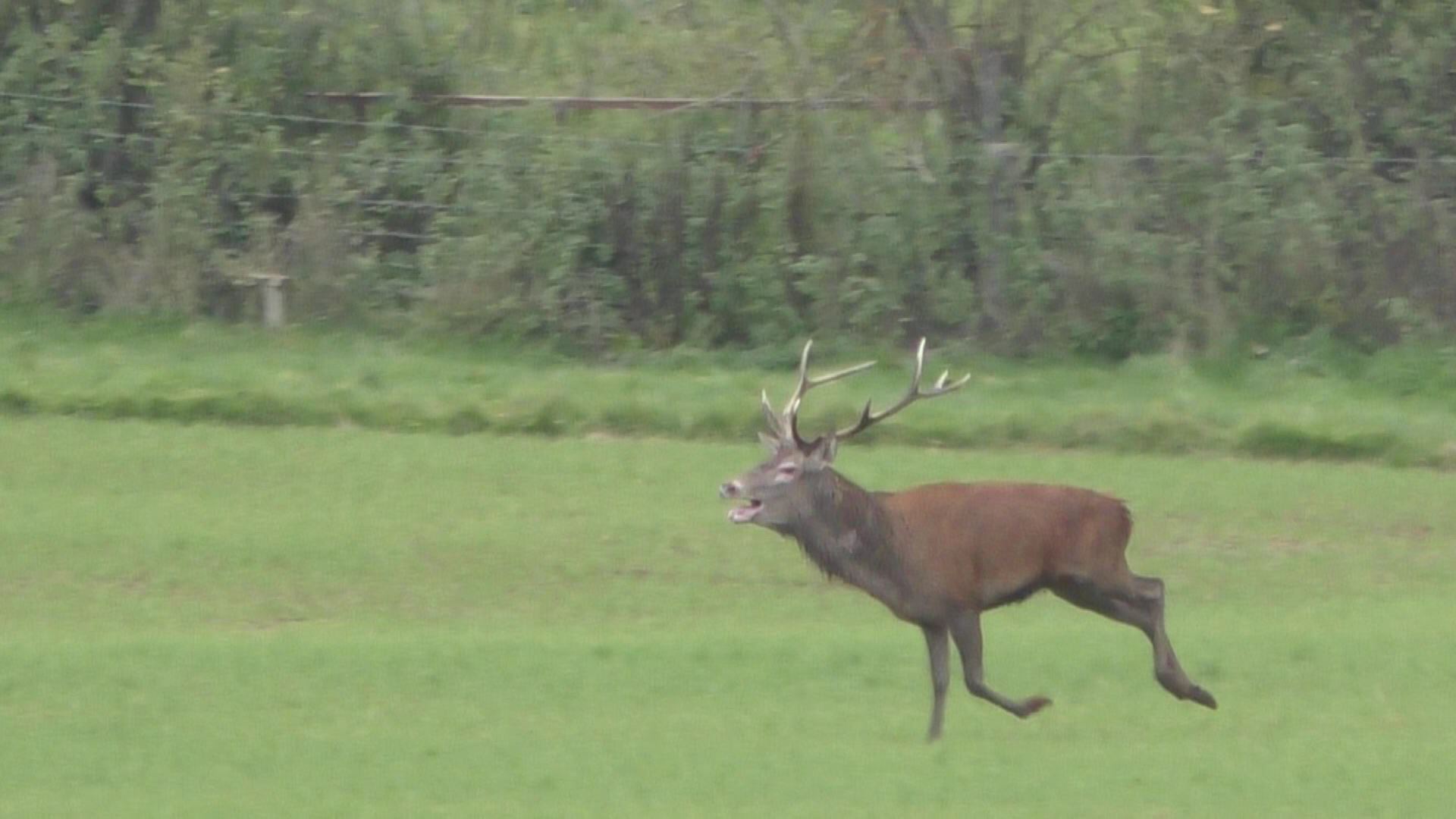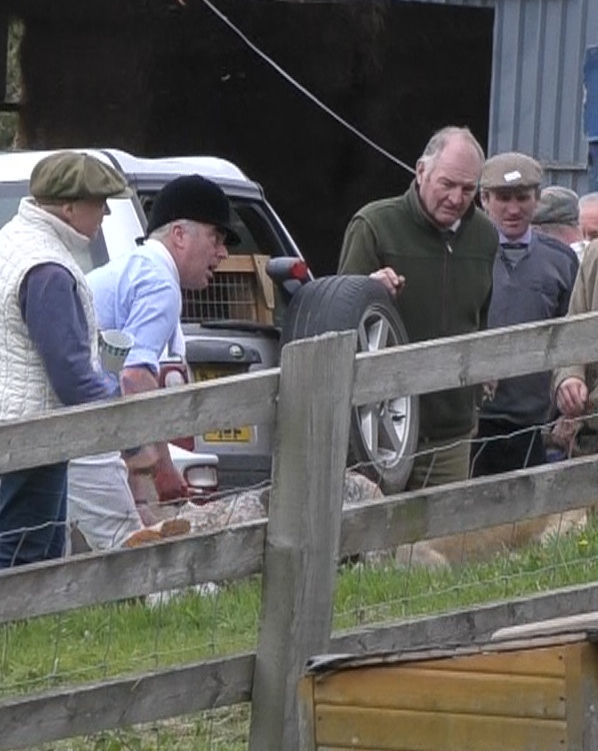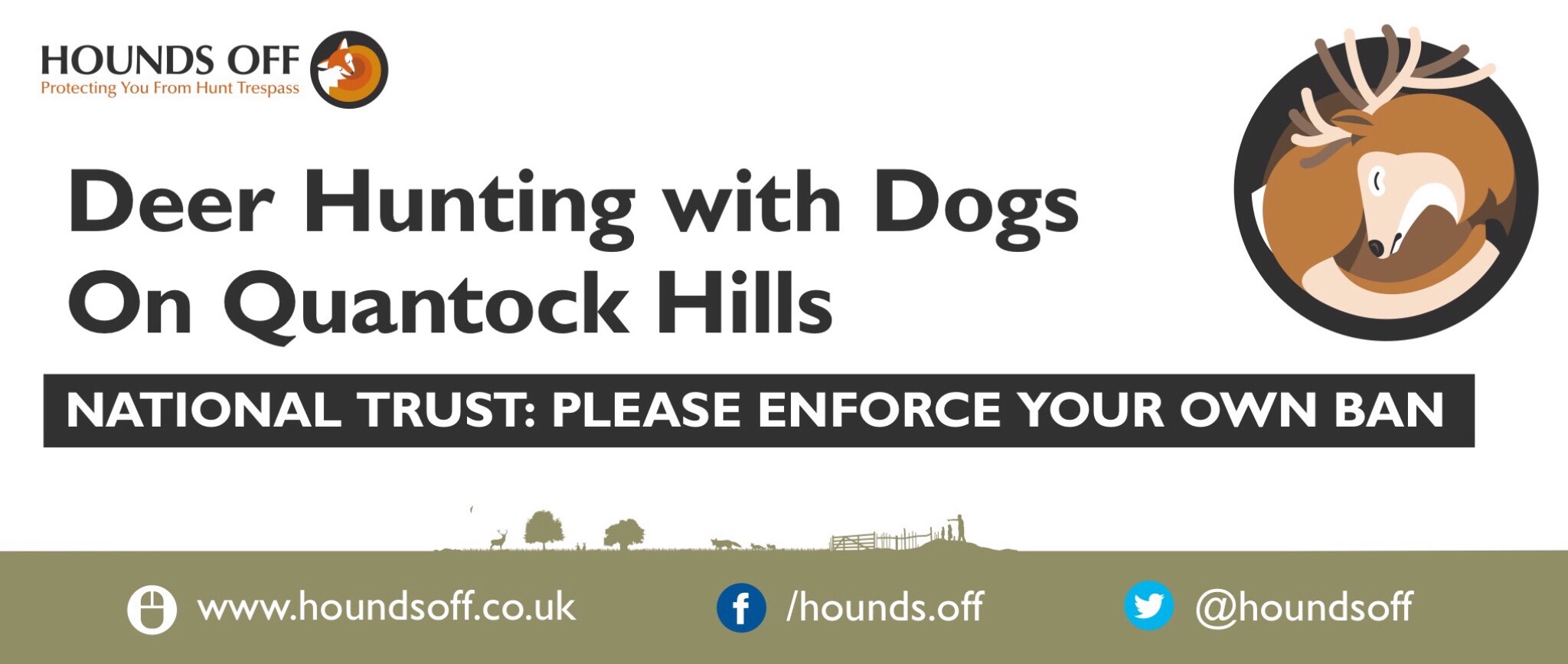30th October 2018
PRESS RELEASE: Stag hunting in Somerset Oct 2018
 Hunted stag runs for his life. Quantock Stag Hounds, 25.10.18
Photo credit: Hounds Off
Hunted stag runs for his life. Quantock Stag Hounds, 25.10.18
Photo credit: Hounds Off
SHOCKING FOOTAGE EMERGES OF STAG HUNTING JUST TEN MILES FROM TAUNTON
- Campaigners have released shocking footage of a Red deer stag being hunted by the Quantock Stag Hounds in Somerset on Thursday 25 October 2018.
- The hunt took place about ten miles from Taunton near the picturesque West Somerset Railway line at Crowcombe Heathfield and lasted for three hours.
- Hunters used combination of horse riders, dogs and four wheel drive vehicles to harass and harry the stag through woods for nearly two hours before forcing him out into the open, and on his own, for another hour.
- After being flushed from the woods, film clearly shows the stag running with his mouth gasping and tongue lolling. There is a heaviness to his gait.
- About an hour later two hounds, which had been set to follow the stag by scent, have chased him to exhaustion. The stag is ‘at bay’ behind a tree in undergrowth. Hounds can be clearly seen ‘marking’ their target; barking incessantly, rushing forwards and jumping back as the stag uses his antlers to keep them from attacking.
- Gunmen from the Quantock Stag Hounds get within close range but the stag jumps up and makes a bid to escape. Hounds give chase and five minutes later, away from cameras, the stag is killed.
- Hunt followers and riders gather in the woods for the traditional carve-up, where the body is divided into trophies for people to take away and remember their day.
Many people think that stag hunting was banned when the Hunting Act (2004) made chasing and killing most wild mammals with dogs illegal. But it hasn’t quite worked out like that. Stag hunters in the West Country have reinvented their bloodsport with subtle differences which allow them to exploit loopholes and exemptions which circumvent the law, including;
- Claiming to be conducting Research & Observation according to Schedule 1 (9) of The Hunting Act (2004), in the same way as Japanese and other whaling nations carry on killing under the pretence of scientific research.
- The Research exemption was intended to enable scientists to carry out their studies if they needed dogs to find a wild mammal. But it does not specify that people claiming Research under this exemption have to be scientists, that their research has to be genuine or that it should be non-lethal.
- The Observation part only requires a hunter to be looking at the stag when it is killed.
- Flushing to guns. The Hunting Act (2004) provides for this in Schedule 1 (1), so long as only two hounds are used and the stag is shot as soon as possible.
NOTES FOR EDITORS
- The National Trust banned stag hunting in 1997 after Professor Patrick Bateson published a report which found that hunting deer with hounds inflicted cruelty and distress far beyond anything they might experience in nature.
- Stag hunting was prohibited on Forestry Commission land in 1997 too.
- Campaigners have documented numerous incidents of trespass by the Quantock Stag Hounds on National Trust and Forestry Commission land during September and October 2018.
- The Quantock Stag Hounds hunt deer with dogs Mondays and Thursdays throughout September to April.
For more information or interviews please contact:
Bobbie Armstrong
Somerset Wildlife Crime: 07572495309
Joe Hashman
Hounds Off: 07711 032697
9th October 2018
Staghunting On The Quantock Hills 08.10.18
 Scene from Quantock Stag Hounds carve up at Staple Farm, West Quantoxhead, Somerset, 8 October 2018.
Scene from Quantock Stag Hounds carve up at Staple Farm, West Quantoxhead, Somerset, 8 October 2018.
There was a moment yesterday when I thought that the Quantock Stag Hounds had decided not to go hunting but alas it wasn’t so. In the end they killed a stag and took the body to a farm to carve it up. Men and women supped cans of drink and watched in gory fascination as the Huntsman, elbow deep in warm blood, dished out bits of inneds and butchered the animal at their feet, in front of their eyes.
They started not far from Bishops Lydiard which itself is a stones throw from Taunton. I was part of a team of Hunt Monitors. We were parked near the beauty spot of Lydiard Hill, by some horseboxes. We anticipated that the Hunt would come in this direction.
Shortly after 11am my radio crackled and the message came through that there was movement our way. Then a gaggle of hunt riders came along the lane, gave us a bit of verbal, loaded their horses into the boxes, and drove off. That was when, fleetingly, I vain hoped they were going to leave stags on the Quantock Hills in peace.
Instead, the Hunt relocated. We got a message that they were up Crowcombe and sure enough that’s where they were hunting.
Staghunting on the Quantocks is not what it was. Prosecutions, campaigning pressure and changing attitudes from the police have forced them to stop using a pack of a dozen or more hounds to chase stags to exhaustion. This season, which started at the end of August, they’ve been using two hounds and an army of riders and vehicle followers to chase and chaperone their quarry. It’s a tactic which staghunters on Exmoor have employed for years now and I think they believe it exempts them from prosecution under the Hunting Act.
There were a couple of huntable stags in Crowcombe Park but an especially big fellow was the target. It took a while for the Hunt to flush him up onto the hills but eventually their pressure forced him out.
I was tracking the Quantock Stag Hounds (QSH) in a vehicle, in communication with others who were both mobile and on foot. From hilltops you get some fantastic views but the Quantock Hills are characterised by large blocks of woodland and numerous steep, deep valleys known as ‘combes’. The staghunters know this landscape intimately and are skilled at operating simultaneously in the open yet out of sight, if that makes sense.
The stag was somewhere below a high spot called Bicknoller Post. Horsemen and women lined the tracks and combe sides. The stag didn’t appear keen to run. It’s mating season for Red deer in Devon and Somerset (the ‘rut’) so likely he was pretty tired from all that. I thought they were going to shoot him there and then but no, they wanted some sport.
What followed was not a high speed, high adrenalin gallop and chase over the countryside. It was more akin to a slow walk. The stag kept low among whatever cover he could find to hide in and the hunters, co-ordinated by radios and aided by their two dogs, pushed the deer along and steered him away from our eyes and camera lenses.
We drove into the picturesque village of Holford. By now we had a hunt supporter tailing us. We waited to let a party of schoolchildren pass. I hoped they saw the anti hunting stickers in the car window and that’s why they smiled and waved and shouted hello as adults in yellow tabbards shepherded them safely to the side. Or, more likely, they were just naturally excited to be exploring such a beautiful place.
A sharp right and left and we were in the car park with dog walkers and tourists. Our hunt tail parked up herself and ran to keep tabs on the foot team we deployed. I drove up a remote, single track lane and at the end was a gathering of elderly hunt supporters in cars.
A number of wooded combes with streams converge at Holford and in the recent past it was a favourite killing place for the QSH. But these days they are no longer Kings of the Hills. They skulk more. Red coats have been swapped for fawny brown. They’re quieter. They still take up a lot of space but they try to avoid clogging villages with four-wheel drives and quad bikes. They are adept at chaperoning their stag quite discreetly away from public gaze.
There were moments while we were in Holford. We heard the hunting horn and urgent, loud shouting. Vehicles travelled at dangerous pace on bumpy lanes back and forth. But nothing more than that came our way.
Our teams of Hunt Monitors communicate by walkie-talkie and telephone, neither of which work well in this area of Somerset. It’s hard to be in the right place at the right time anyway but when communications are poor because the signal isn’t great it’s even harder. We believed that the hunted stag had left the Hills for farmland near Kilve but weren’t sure.
The stag was killed south of the A39 near Kilve late in the afternoon, in the depths of private property, and taken to a nearby farmyard for the post-orgasmic ‘carve up’. They were not happy about us trying to take some pictures and it was difficult anyway as they’d hidden themselves behind buildings. Out of sight but not out of our minds.
That was the bloody reality of staghunting on the Quantock Hills this day, 8th October 2018.
Volunteers from Hounds Off and Somerset Wildlife Crime continue to monitor staghunting on the Quantocks, bear witness and gather evidence to show how hunts are operating. You can . Mark your donation ‘QSH’ and we will dedicate it to this specific fund.
© Joe Hashman
12th September 2018
Your Membership & Voice Matters #Bateson
Since 1988 there have been five National Trust (NT) Members Resolutions against hunting with hounds. Some were defeated, others were carried. Way back in 1990, the Chairman used between 30 and 40 thousand proxy votes in an attempt to defeat two motions presented to the AGM. It only half worked because one, the Cronin-Wilson Resolution (to ban staghunting on NT land), was carried by 68,679 to 63,985.
That Members voted to stop this particularly hideous form of rural entertainment rocked the NT Ruling Council and the hunting community at large.
The Ruling Council ignored the Members. Instead of implementing a ban, they set up a Working Party crammed with hunting sympathisers to investigate the implications of a ban whilst specifically ignoring the abuse of and suffering caused by deer hunting with dogs. Predicatably, the Working Party recommended no ban on staghunting. The hunting fraternity, amid threats of rural vandalism and disobedience if the bloodsport was prohibited, urged their supporters to join the NT in an effort to swing the balance of power in their favour. There was a battle royal being waged within and around the NT.
Lord Soper was President of the League Against Cruel Sports at the time and also a member of the NT. His Members Resolution to a NT Extraordinary General Meeting held on Saturday 16 July 1994 (The Soper Resolution) called for a “balanced Working Party to be convened to consider the aspects of cruelty and welfare that were ignored previously.” It was carried by a whopping 114,857 to 99,607.
In April 1995 the NT Ruling Council invited Professor Patrick Bateson of Cambridge University to conduct a two-year scientific study into the welfare implications of hunting deer with hounds. He and his team did this with the full co-operation of West Country staghunts and the League Against Cruel Sports. The findings were published as ‘The Behavioural and Physiological Effects of Culling Red Deer’ (aka The Bateson Report). The evidence of cruelty inherent in staghunting and the proven effects of suffering caused to hunted deer, regardless of whether they were eventually killed or not, stunned all concerned. The day after being presented with The Bateson Report, the NT Ruling Council (to its credit) agreed not to renew any licences for staghunting on NT land.
After a couple of days shame and shock, the hunters fought back. Among other tactics, Countryside Alliance President and staghunting apologist Baroness Mallalieu set up Friends of the National Trust (FONT) with the aim of getting their people elected onto the NT Ruling Council and overturning the staghunting ban. Even now in 2018, FONT has not fully succeeded, but under the disguise of pro hunting organisations and individuals they are still trying.
You Membership matters and your voice counts!
© Hounds Off
Editor's picks
- Best Casino Sites Not On Gamstop
- Online Casinos Not On Gamstop
- UK Betting Sites
- UK Online Casinos Not On Gamstop
- Gambling Sites Not On Gamstop
- Non Gamstop Casinos
- Sites Not On Gamstop
- Non Gamstop Casino Sites UK
- Non Gamstop Casino Sites UK
- Non Gamstop Casino Sites UK
- Non Gamstop Casino Sites
- Top Casino Sites UK
- Casino Not On Gamstop
- UK Online Casinos Not On Gamstop
- UK Casino Not On Gamstop
- Casino Sites Not On Gamstop
- UK Casino Sites Not On Gamstop
- UK Online Casinos Not On Gamstop
- Best Betting Sites
- Casinos Not On Gamstop
- Best Non Gamstop Casinos
- Betting Sites Not On Gamstop Uk
- Sites Not On Gamstop


